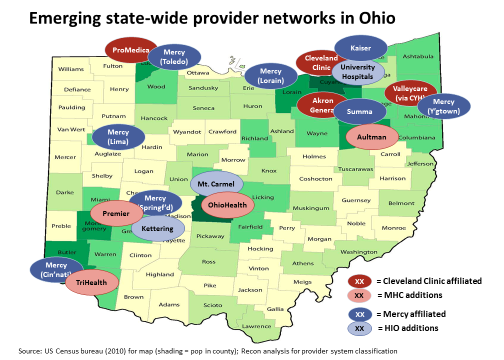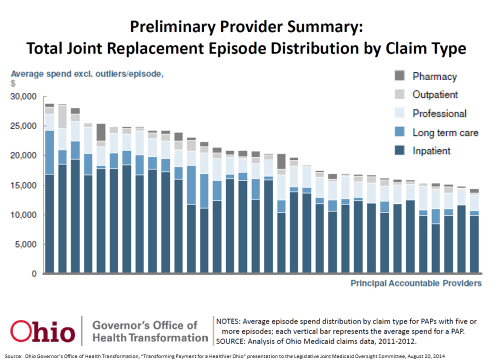A few days ago, Cleveland Clinic announced the formation of the Midwest Health Collaborative (“the Collaborative”), a new company jointly managed by six Ohio delivery systems across the state. The company’s goals are to share best practices, collaborate to reduce costs (e.g., procurement synergies) and “explore the business case” for developing a state-wide provider network. Notably, the deal was announced just eighteen months after Cleveland Clinic’s key competitor in Ohio, Mercy Health (formerly Catholic Health Partners), announced its own state-wide alliance, Health Innovations Ohio; this new deal also links three major southern Ohio provider systems (which directly compete with Mercy Health on its “home turf”) with the Cleveland Clinic.
Is Toby Cosgrove — like Ulysses Grant advanced along Mississippi River to lay siege to Vicksburg — now moving along the I-71 corridor to bring enhanced competition to Mercy Health’s Cincinnati doorstep?
Competitive context
Competition between the Cleveland Clinic and Mercy Health broke wide a few years ago. Most of the fight has been in northern Ohio in a game of tit-for-tat acquisitions and alignments with mutually competing systems in Cleveland, Akron, Youngstown, and Toledo. In 2012, Mercy launched (initially in “stealth mode”) the Health Innovations Ohio (HIO) as an alliance across four (later five) systems. The HIO alliance solidified the relationship with some Mercy partners (e.g. Summa in Akron) and brought new systems in the Mercy orbit (including Cleveland Clinic’s most direct competitor: University Hospitals). The goals of the organization were to collaborate on Medicare Advantage (two of the partners ran their own plans), accountable care in Medicaid and best practice sharing. The competitive impact was to shift the game from market-by-market battles to a state-wide duel with geographic reach, scale and health plan subsidiaries as levers. One early taste of this power: In Columbus, Mt. Carmel’s Medicare Advantage went from 38K to 50K members since HIO was announced.
Despite the HIO competitive threat, however, we believe that the Collaborative is a response to Ohio’s changing regulatory environment than to Mercy Health. And, while Cleveland Clinic’s reach is now extended into Columbus and Cincinnati, we believe it was the southern systems that sought out the Clinic as much as — or more than — Cosgrove went looking for a southern beachhead vs. Mercy Health. Cosgrove may be moving south, but we think somebody other than Mercy should be worried.
It’s Kasich’s world now…Mercy, the Clinic and others are just living in it
Governor Kasich established the Office of Health Transformation (OHT) in 2011 with missions to modernize Medicaid, streamline health and human services administrations and drive value-based payment. In October 2013, after much study and some piloting, the Office released its plan to get — within five years — 80% of the state’s medical spend and 80-90% of the state’s population to receive care tied to value-based reimbursement in two prongs: patient centered medical homes and episode-based payments.
Reaching that goal will require speed, aggressive use of the state’s purchasing authority (Medicaid, state employees) and collaboration with the system leaders. The patient centered medical home is to be rolled out geographically: it was being piloted in southwestern Ohio in 2013 with 250 physicians and 220K patient lives and has now reached over 500 sites. Starting in 2015, OHT is planning to scale up and broaden the patient centered medical homes initially in Columbus and Cleveland. Also starting in 2015, the episode-based payment system is to be launched — initially focusing on five categories: asthma, perinatal, COPD, PCI and joint replacement, adding another 15 episode categories in year 3 and reaching 50+ by year 5. Bold goals, but a credible enough plan to win a $75M award from CMS late last year to support model roll-out.
There will be winners and losers in episode payment model. And the damage could be painful. For joint hip replacement, for example, costs appear to range from ~$14K to more than $28K (based on our eyeballing the chart below from an OHT presentation in August 2014).
All the leaders of Ohio provider systems have been looking at variation on these charts for the past year or two and knowing exactly where they stand on the distribution. Just coincidence that negotiations for the Midwest Heath Collaborative started in November 2013, one month after OHT published is strategic plan?
The scramble
The Collaborative’s southern providers are among the top rated in their markets. In Cincinnati, for example, TriHealth’s two hospitals are the #1 and #2 in the metro area (with Bethesda ranked nationally in 7 specialties). Among Mercy Health’s Cincinnati hospitals, Jewish is ranked #6 in the city (no nationally ranked specialties); the other five hospitals are all unranked. Elite positioning like that could be very valuable in sustaining high rates in traditional competition. With value-based reimbursement, however, cost structures to support high rankings can become an economic “health hazard.”
Mercy Health is diving in with both hands:
- Aggressively pursuing Level 3 PCMH designations from NCQA (in Cincinnati, for example, 37 practices designated in 2012, 56 practices in 2014 and another 37 already so far in 2015)
- Nipping at the quality heals of its higher ranked competitors (e.g. winning an innovation award from Premier in February 2014; two hospitals earning Truven Top 100 ranking the following March)
- Building out big data capabilities: Epic roll-out across its various systems; Explorys since 2011 and expanded in 2015, leveraging its position with Premier (via for example, participation in a Data Alliance Collaborative with Premier and IBM, participating in the PACT population health collaborative)
There is plenty of evidence that the southern members of the Midwest Health Collaborative could benefit from Cleveland Clinic experience:
Patient centered medical homes
The picture varies a bit by market (see chart above). In Cincinnati, Mercy has a strong PCMH position with 130 designated homes. But so does TriHealth (part of the Collaborative) with 70 homes. In Columbus and Dayton, however, the Cleveland Clinic “team” seems to have some catching up to do (see chart above). Notably, OhioHealth signed a deal with Explorys in April 2014 and Premier Health signed up with Evolent in October. Cleveland Clinic is an old hand at PCMH, having their Medicine Institute designated as far back as 2010 and, most recently, from the Joint Commission in 2014.
Episode payments
More important may have been the episode payment model which is targeted to start coming “on line” in 2015. Cleveland Clinic has been one the major CMS partners on episode payment initiatives for some time. In Ohio, they currently lead among convening organizations with bundled payment pilots in 9 hospitals covering 48 different episodes. No doubt their experience will be very useful to the other systems as they too start down the path of preparing for bundled payments. As for the other partners: OhioHealth has pilots at 5 hospitals but only for 13-22 episodes (varies by site); TriHealth and Premier appear to have none currently going on at their hospitals and may be facing a “cold start.”
One other bit of evidence that the Collaborative was about experience sharing vs. a Cleveland Clinic competitive intent: Reportedly, the CEOs of the six partners will make up the new company’s board and each has a single vote — despite the very different sizes of the partners (ranging from Premier’s 1.7K beds or Aultman’s 550 beds). The equal voting suggests a hardwired respect for the needs of each system over, say, size, brand power or the competitive needs of any one player.
Insurers at risk?
If the Collaborative is more about mastering the shift to value-based health than competing with Mercy, who should feel threatened? Perhaps health insurers should be most concerned. Now, thirteen of the top fifteen provider systems in Ohio are involved in one of two broad alliances, each covering the core geographies of the state and working together to survive the coming transformation. Employers have amply demonstrated impatience with health plans’ network designs structured to meet the “weighted average needs” of their current customers. It is not at all hard to see how these alliances can become the potential for state-wide network plays with employers carving out the network from the plans via direct contracting.
And not just insurers in Ohio should pay attention: state-level transformations drives providers to think in terms of state boundaries instead of traditional medical catchment areas. The scenario playing out in Ohio appears to be this: value based reimbursement transformation –> need for best practice sharing across providers –> formation of alliances among in-state providers –> harmonization around data flows and best practices –> creation of a viable, collaborating state wide network. This logic won’t be limited just to Ohio: recall the $75M grant OHT received to drive the transformation. This past December, ten other states won comparable Model Test Awards worth $550 million from CMS. We may see viable state-wide provider owned and operating networks in a lot more states coming soon.
Written by Tory Wolff and Diana Poon



